Real pirates didn’t say “arrgh.”
That was the actor Robert Newton, in his portrayals of Long John Silver and Blackbeard in movies and television. Obviously, it caught on.
Pirates didn’t make their victims walk the plank either.
Not when it was so much easier (though admittedly less dramatic) to simply throw captives overboard. Give credit to illustrator Howard Pyle for that romantic image, his painting of a blindfolded man edging out on a wooden plank captures all of the crippling fear that such a punishment would induce.
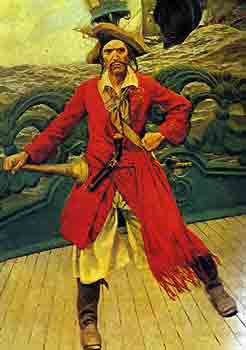 Nevertheless, pirates were very real. They did drink rum by the caseload. They were reckless and wild and daring. Some even owned parrots and monkeys as pets. Their real stories are so nightmarish that the fiction they inspired often seems tame by comparison.
Nevertheless, pirates were very real. They did drink rum by the caseload. They were reckless and wild and daring. Some even owned parrots and monkeys as pets. Their real stories are so nightmarish that the fiction they inspired often seems tame by comparison.
It’s no wonder then, that pirates, buccaneers and freebooters still loom large, even in the twenty-first century. They are our most beloved outsiders, particularly among long-term travelers—roaming free, making their own rules, completely in the moment. So many novels, movies and songs honor their bold deeds and gruesome deaths that it’s easy to forget that these rogues actually existed. Any savvy jack-tar worth his salt can track down one of the many pirate festivals celebrated yearly, but even more fascinating is a visit to their real stomping grounds. Some of which haven’t changed as much as one might think.
Here are 5 places that any aspiring pirate historian ought to visit:
1 – Saint Mary’s Island, Madagascar
Known these days by the French name Ile Sainte Marie, Saint Mary’s was once the central hub of piracy and nefarious dealings in the Indian Ocean. Notable scalawags Captain Kidd, Robert Culliford and Henry Avery all took refuge on the island at one time or another to buy supplies, drink homebrewed rum and savor the company of the notoriously beautiful Malagasy women.
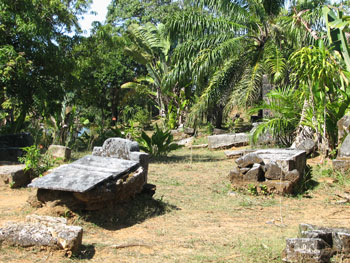
Trader Adam Baldridge set up shop on Saint Mary’s and supplied his guests with everything they might need, at a healthy markup of course. Captain Kidd had a hard time getting his crew motivated again after his turn ashore on the island and many of them abandoned him there.
A 21st century traveler visiting Sainte Marie would be missing out if they didn’t take a stroll through the pirate graveyard that overlooks the “Bay of Rogues.” The bay is where some of history’s most notorious sea-devils weighed anchor. The site is shaded by trees and vines and can be reached along a short and often muddy path from the beach. The mossy headstones feature skulls & crossbones and the sentiments etched there show little remorse for the deeds of the men buried below.
If you want to be where the crème de le crème of pirate society went to revel—go to Saint Mary’s. Consider the perfect beaches, jumbo prawns and friendly modern residents to be a bonus.
2 – Port Royal, Jamaica
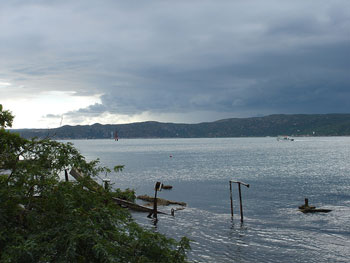 Thanks to Jack Sparrow’s ringing endorsements in the Pirates of the Caribbean movies, Port Royal may be the destination most commonly associated with piracy’s Golden Age. There is both truth and fiction in that assertion—Port Royal was once the world’s premier pirate haven but its heyday was before the Golden Age of Piracy (1690-1720).
Thanks to Jack Sparrow’s ringing endorsements in the Pirates of the Caribbean movies, Port Royal may be the destination most commonly associated with piracy’s Golden Age. There is both truth and fiction in that assertion—Port Royal was once the world’s premier pirate haven but its heyday was before the Golden Age of Piracy (1690-1720).
In the 1660s however, Port Royal was the carousing capital of the world. Records indicate one alehouse for every ten permanent residents. Ships often came into port rich and left drunk, fat and happy—but drained of plenty of gold coins. Nicknamed “The Sodom of the New World,” Port Royal existed in a state of revolving revelry.
The Gentlemen of Fortune who made Port Royal famous are generally put into the category of Buccaneers and many of them had defended the city from the Spanish or plundered Spanish treasure ports in time of war. When the crown decided that Jamaica needed to change its image they hired one of these unsavory types to do it for them. His name was Captain Henry Morgan and though he was known for taking a bribe here and there and attacking Spanish ships even in times of peace, his work to fix the island’s bloody reputation met with success.
Regardless, the point was soon moot. In 1692, most of the port sunk under water during a devastating earthquake. Some were quick to attribute the quake to an act of God (who was either furious with the hedonism of the people or jealous of all the fun they were having, depending on who you asked). Attempts to rebuild the city went up in smoke (literally, two major fires in ten years) but it did later become a popular execution spot where pirates Calico Jack Rackham and Charles Vane went to meet the gallows.
These days, Port Royal is small and known mostly for fishing—but as a site for pirate lovers and those interested in underwater archeology, it is unparalleled in the Caribbean and certainly worth a visit.
3 – Nassau, Bahamas
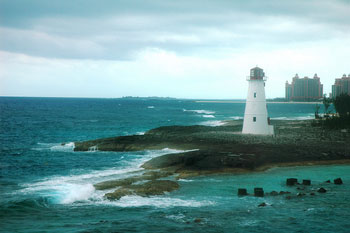 At the turn of the 18th century, the island of New Providence in the Bahamas was a scarcely governed haven for gentlemen of fortune. Retired buccaneers and upstart pirates lived in squalor under tents made from pieces of old sail.
At the turn of the 18th century, the island of New Providence in the Bahamas was a scarcely governed haven for gentlemen of fortune. Retired buccaneers and upstart pirates lived in squalor under tents made from pieces of old sail.
Governor Nicholas Trott was well known for taking bribes from men who were sought by the British Crown. When the aforementioned Henry Avery needed someplace to hide out he was sent straight to New Providence. Trott was only too happy to help for a share in Avery’s plunder. Soon even the puppet governments failed and New Providence became a no man’s land split between pirate chieftains.
Later, when England made the Bahamas a colony and decided to clean up Nassau, the Lords Proprietor took a page out of Jamaica’s playbook and called in a gentleman of fortune. This time it was Woodes Rodgers. Rodgers knew the men and knew their tactics—it wasn’t long before Nassau fell off the list of preferred pirate ports.
Today, Nassau has been scrubbed to a high shine. The spit of sand across the harbor from the port even had its name changed to Paradise Island (the pirates knew it as Hog Island). Nassau Town still clings to snippets of old world charm that reference its past, though they are often tough to focus on between cruise ships and modern resorts. Luckily, the Pirates of Nassau Museum does a great job of reminding us of the way things were.
4 – North Carolina, United States
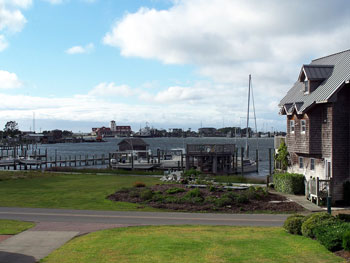 The Carolina Coast has no shortage of pirate lore. There are stories of shipwrecks, battles and buried treasure—all of which pale in comparison to the deeds of one Edward Teach a.k.a. Blackbeard. Blackbeard was tough as coffin nails, at least half-crazy and would sometimes burn slow match in his beard to scare enemies. Not surprisingly, he was an effective pirate.
The Carolina Coast has no shortage of pirate lore. There are stories of shipwrecks, battles and buried treasure—all of which pale in comparison to the deeds of one Edward Teach a.k.a. Blackbeard. Blackbeard was tough as coffin nails, at least half-crazy and would sometimes burn slow match in his beard to scare enemies. Not surprisingly, he was an effective pirate.
After leaving New Providence due to the arrival of Woodes Rodgers, he set up camp on Ocracoke Island. From there he and his crew set out pillaging throughout the Caribbean and into the Gulf of Mexico. In 1718, after blockading the Port of Charles Towne and ransoming the entire city, he and his men returned victorious and rich to Ocracoke. Weeks of carousing followed until the governor of Virginia decided to send Lieutenant Maynard and his Royal Navy crew to do something about the pirate infestation.
The chase between Maynard’s crew and Blackbeard’s freebooters was brutal and bloody. But it was the final battle, in which Blackbeard took five bullets and more than “20 dismal cuts” before dying, that is the stuff of legends.
The best account we have of the battle, which describes Blackbeard fighting with three men at once, also attributes a quote to him AFTER receiving a death blow by broadsword to the neck. It wasn’t until his head was completely off of his shoulders that Maynard’s crew stopped fearing him, and even then just barely.
Today North Carolina’s coast has plenty in store for a visitor interested in pirate history. Blackbeard’s memory hangs over the island of Ocracoke and the towns of Beaufort and Bath. Many artifacts from the dreaded pirate’s ship, The Queen Anne’s Revenge, are on display in museums throughout the state including Beaufort’s Maritime Museum. The area also happens to one of the United States’ least appreciated stretches of beach—which any visitor should be able to enjoy heartily.
5 – Vailima, Samoa
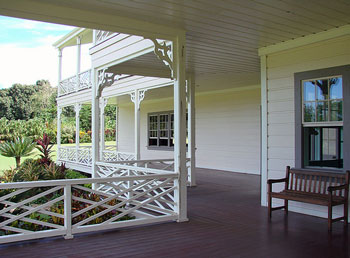
Samoa wasn’t a hotbed of activity during the Golden Age of Piracy. But it’s notable for one very famous resident: Robert Louis Stevenson. Treasure Island is the definitive pirate novel, and the blood-thirsty crew that populated the schooner Hispanola is responsible for many of our most vivid notions about freebooters.
Most notably, as David Cordingly points out in his book Under the Blag Flag, Stevenson popularized parrots and peg legs, both of which were real parts of life at sea but not yet cemented in the public consciousness.
Stevenson originally travelled to the South Seas to ease his chronic health problems. It wasn’t long before he fell in love with the islands and their people. For their part, the natives of the South Pacific liked the frail writer just as much—he quickly developed an enduring friendship with King Kalakaua of Hawaii.
Known as a culturally sensitive traveler long before the phrase was common, Stevenson established a home on Vailima when he was forty. Four years later he died there and his old residence is now a museum honoring his memory.
Additional photo credits:
Port Royal by Christian y Sergio on Flickr, Bahamas by LinksmanJD on Flickr, North Carolina by greenkayak73 on Flickr, Samoa by anna t on Flickr